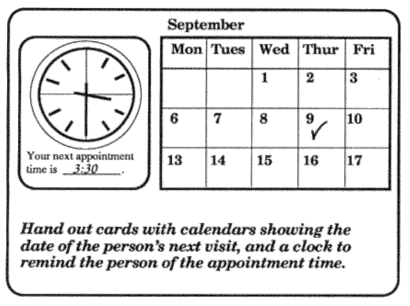Make People Feel Comfortable
Think about what happens to a person who uses your services. Are
there ways to make someone with poor literacy skills feel more
comfortable each step of the way? Are there opportunities for you to
tell if the person has a problem reading and writing? Do you take
advantage of these opportunities? Here's how you can.
Listen and talk
- Listen for clues as the person tells you about the issue that
your agency will help with.
- Make sure that the person understands any instructions you have
to give. Ask if it is all clear. Ask the person what their next step
will be, to make sure they know. Don't rely on a piece of paper or a
pamphlet to explain how your system works, or to get someone back
for a meeting. Give people a calendar page and a small drawing of a
clock showing the time and date of the person's next visit, instead
of a written appointment slip.
- Train your staff. Call a literacy organization and ask if someone
could come by to speak to your workers and volunteers about how they
can best serve people who don't read and write well. Take the
opportunity to find out about literacy programs in your area, so
that you can recommend them to people who might be interested.
Can you do your work a little differently?
- Take a look at your programs. Many have lots of opportunities for
staff and volunteers to see if a person has a hard time reading and
writing. Do you ask people joining in on your programs to read
manuals or instruction sheets? Do they have to make lists or keep
track of money? If they do, you have an opportunity to watch for
people who try to avoid doing things in ways that involve reading,
writing, and using numbers. But maybe you could change the way parts
of your programs work so that people won't have to do so much
reading and writing...

- In group workshops, do you ask people to write down ideas or
describe their problems or challenges in writing? How about inviting
people to use tape recorders instead? Give everyone a choice. Don't
divide up the group into good writers and poor writers. Let each
person decide whether they'd rather be part of the group that writes
their answers, or the group that uses tape recorders. And if
you use tape recorders, make sure that you show people how your
machines work.
- Invite a literacy worker to help your staff and volunteers find
other ways to make people with poor reading and writing skills more
comfortable using your services. And ask the worker to give you
ideas on what to look for to tell if someone might need to brush up
on these skills.
If you know there's a problem...
- If different staff members and volunteers will work with someone
who has difficulty reading and writing, consider using colour codes
on your files to let workers know. In this way, workers can think
about how they can do their work without embarrassing the person.
Talk about literacy programs
- Let people who use your services know about literacy programs in
your area. Could literacy be one of the services you let people know
about as a matter of course? If you offer life skills or employment
skills programs, you may want to invite a literacy worker or a
literacy student to talk to each of your groups. When talk about
literacy is a normal part of a program, it can make it easier for a
person to take the next step. And word of mouth is the number one
way that people find out about literacy programs and get interested
enough to join them.
- If you know someone who uses your services and who might be
interested in taking a literacy course, take your time bringing the
subject up. As you and that individual get to know one another, you
can develop a relationship of trust.
That trust is important. People need to know that you are really
interested in hearing about whether reading and writing is a problem,
and whether they want to do something about it. They may need time to
think things over. Give them all the time they need. The literacy
programs will wait.
|
